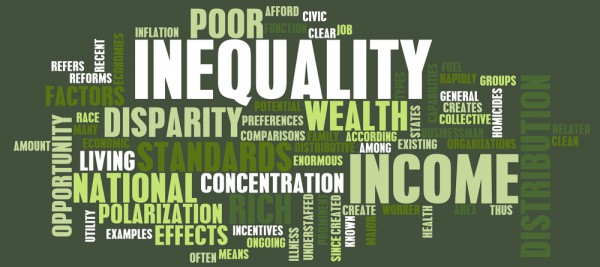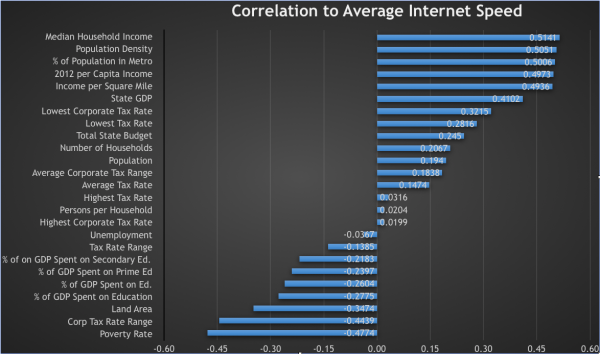
Access to fast, reliable Internet empowers people to learn for themselves. It gives them the means to solve their own problems. It eliminates one of the obstacles that stands in the way of the oppressed knowing how others have freed themselves in the past. Unfortunately, we found that low-income areas with the most to gain from access to the world’s knowledge, continue to lag behind in Internet speeds.
On average, states whose populations are made up of people with lower incomes living in rural areas are likely to have the slowest Internet speeds. In order to gain a greater understanding of the role of wealth in regards to Internet speeds, we compared average Internet speeds for all 50 states with several financial factors.
The only economic factors we found that show any significant relationship with Internet speed were the ones that indicate wealth on a personal level. There was no significant relationship between Internet speed and a state’s Total GDP, its tax rates, or its unemployment rates.
The average Internet speed in a state is related to the average wealth of the people in that state, not to the wealth of the state itself (as shown in the chart below).
High Correlations with Population Distribution Found
One other place where we did see a significant correlation was the percentage of a state’s population living in a metropolitan area. We found that correlation to be 0.50. That relationship was also reflected in the 0.51 correlation we found between Internet speeds and population density.
This makes sense. It is more efficient to provide Internet to many people at once, than it is one at a time. It costs nearly the same total dollar amount to build the infrastructure of a broadband line whether it delivers Internet to one house or to a high-rise apartment building. But, with the apartment building, you get to charge everyone for the service. With the house you've only gained one customer. Under this paradigm, any savvy business owner would roll out their best services to metropolitan areas first.
The divide in economics and slow Internet access likely compounds problems that states like Wyoming and Montana have; 66 percent of the Montana population lives in rural areas, and they have the second slowest average Internet speeds. That combination is difficult to overcome.

Financial indicators correlated with average Internet speeds by state
Tough Questions Are Ahead for Rural and Low Income Communities
While seeing sub-par Internet speeds in places with poor and rural populations makes sense, it also raises questions about the future for such areas:
- If there is little business incentive for corporations to service these areas, then should the government provide the infrastructure?
- If so, then with which funds?
- If not, then are governments forsaking their people to involuntary ignorance?
These types of questions are already being debated in municipalities weighing the pros and cons of publicly-funded Internet. They will likely be answered differently depending on the values of each individual community.
Worldwide Correlations Are Stronger
The puzzle of high-speed Internet access and the role it plays in human advancement extends beyond the United States. In fact, the personal wealth correlation is even stronger on a global scale.
For the 125 countries on which we have data, we found a correlation of 0.79 between the percentage of the population with a broadband subscription and the GDP per capita. We also found a correlation of 0.78 between the percentage of the population using the Internet and GDP per capita. These finding coincide with the information we previously found about the digital divide and GDP.
The likely explanation for these huge correlations internationally as opposed to the smaller correlations from state to state is that there is such a huge variation in both categories from nation to nation. The variation of GDP per capita across the nations for which we have data was over $100,000, while the same variation across the states was just under $40,000. There was a similarly gargantuan gap in the variations in the percentages of populations using the Internet. That variation across our international data set was 94.91 percent, but it was only 24 percent across our state data.
Improving Internet Speed Is Important
It seems fitting that the population element plays a large role in the data. A population is made up of individual people. The importance of research like this lies in the effect it can have on individual people.
The Internet has the opportunity to be the great equalizer in our world. It creates a gateway to an enlightened global society and, as we've shown before, it relates to people's intelligence and happiness. Unfortunately, individual financial factors seem to limit Internet access and speed.
As communities across America decide whether they should publicly fund Internet infrastructure, they have the opportunity to make a statement about the importance of high-speed Internet. By understanding the cultural environment of the Internet, we can all work to remove the barriers that keep people from accessing the wealth of knowledge the Internet provides. Just as knowledge is power, enlightenment is empowerment.
This article first appeared at Internet and Inequality -- The Digital Divide Gets Personal
 John continually offers unique insights and a fresh point of view. Along with writing, John has a passion for music. He is the lead vocalist and secondary guitarist for The Family Gallows in Salt Lake City.
John continually offers unique insights and a fresh point of view. Along with writing, John has a passion for music. He is the lead vocalist and secondary guitarist for The Family Gallows in Salt Lake City.
Photo Credit: kentoh/Shutterstock

